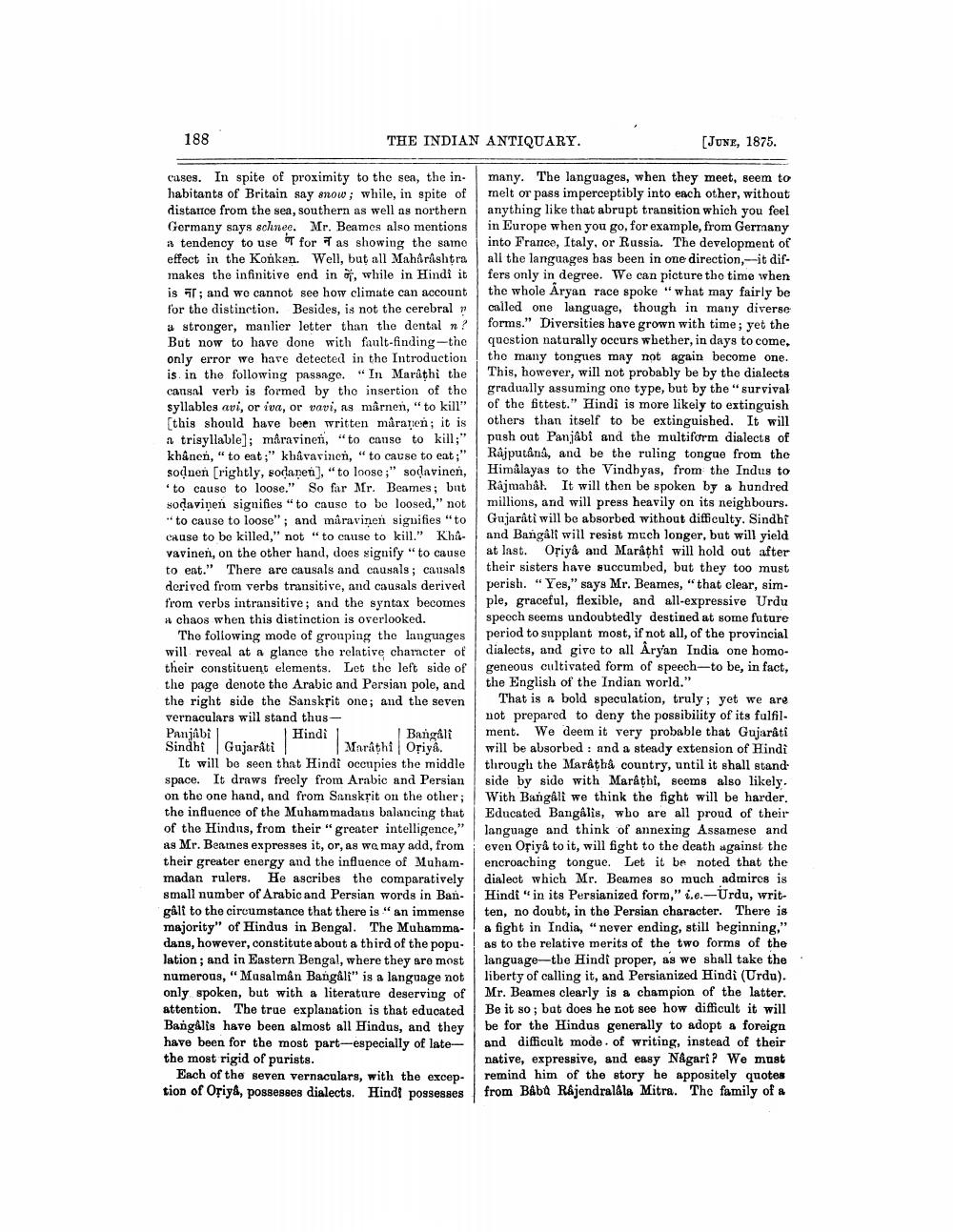________________
188
THE INDIAN ANTIQUARY.
[JUNE, 1875.
cases. In spite of proximity to the sen, the in. habitants of Britain say snow; while, in spite of distance from the sea, southern as well as northern Germany says schnee. Mr. Beames also mentions # tendency to use T for Tas showing the samo effect in the Konkan. Well, but all Maharashtra makes the infinitive end in , while in Hindi it is Fr; and we cannot see how climate can account for the distinction. Besides, is not the cerebral a stronger, manlier letter than the dental n? But now to have done with fault-finding-the only error we have detected in the Introduction is in the following passage. "In Marathi the cansal verb is formed by the insertion of the syllables avi, or iva, or vavi, as marnen, "to kill"
this should have been written máranien; it is a trisyllable]; maravinen, "to cause to kill;" khanen, "to eat;" kbâvarinen, "to cause to eat;" sodnen [rightly, sodanen), "to loose;" sodavineń, 'to cause to loose." So far Mr. Beames; but sodavinen signifies to cause to be loosed," not - to cause to loose" and maravinen signifies "to cause to be killed," not "to cause to kill." KhiVavinen, on the other hand, does signify "to cause to eat." There are causals and causals; causals derived from verbs transitive, and causals derived trom verbs intransitive; and the syntax becomes #chaos when this distinction is overlooked.
The following mode of grouping the languages will reveal at a glance the relative charcter of their constituent elements. Let the left side of the page denote the Arabic and Persian pole, and the right side the Sanskrit one; and the seven vernaculars will stand thusPanjabi
Hindi
Bangali Sindhi Gujarati Marathi Oriya.
It will be seen that Hindi occupies the middle space. It draws freely from Arabic and Persian on the one hand, and from Sanskrit on the other; the influence of the Muhammadang balancing that of the Hindis, from their "greater intelligence," as Mr. Beatnes expresses it, or, as we may add, from their greater energy and the influence of Muhammadan rulers. He ascribes the comparatively small number of Arabic and Persian words in Bangalt to the circumstance that there is an immense majority" of Hindus in Bengal. The Muhammadans, however, constitute about a third of the population; and in Eastern Bengal, where they are most numerous, "Musalmån Bangali" is a language not only spoken, but with a literature deserving of attention. The true explanation is that educated Bangális have been almost all Hindus, and they have been for the most part-especially of latethe most rigid of purists.
Each of the seven vernaculars, with the excep- tion of Oriya, possesses dialects. Hindi possesses
many. The languages, when they meet, seem to melt or pass imperceptibly into each other, without anything like that abrupt transition which you feel in Europe when you go, for example, from Germany into France, Italy, or Russia. The development of all the languages has been in one direction, --it differs only in degree. We can picture the time when the whole Aryan race spoke "what may fairly be called one language, though in many diverse forms." Diversities have grown with time; yet the question naturally occurs whether, in days to come, tho many tongues may not again become one. This, however, will not probably be by the dialects gradually assuming ono type, but by the survival of the bittest." Hindi is more likely to extinguish others than itself to be extinguished. It will push out Panjabi and the multiform dialects of Rajputâna, and be the ruling tongue from the Himalayas to the Vindhyas, from the Indus to Rajmahal. It will then be spoken by a hundred millions, and will press heavily on its neighbours. Gujarati will be absorbed without difficulty. Sindhi and Bangali will resist much longer, but will yield at last. Oriya and Marathi will hold out after their sisters have succumbed, but they too must perish. "Yes," says Mr. Beames," that clear, simple, graceful, flexible, and all-expressive Urdu speech seems undoubtedly destined at some future period to supplant most, if not all, of the provincial dialects, and give to all Aryan India one homogeneous cultivated form of speech-to be, in fact, the English of the Indian world."
That is a bold speculation, truly; yet we are not prepared to deny the possibility of its fulfil. ment. We deem it very probable that Gujarati will be absorbed : and a steady extension of Hindi through the Maråthå country, until it shall standside by side with Marathi, seems also likely. With Bangali we think the fight will be harder. Educated Bangalis, who are all proud of their language and think of annexing Assamese and even Osiyå to it, will fight to the death against the encroaching tongue. Let it be noted that the dialect which Mr. Beames so much admires is Hindi " in its Persianized form," i.e.-Urdu, written, no doubt, in the Persian character. There is a fight in India, "never ending, still beginning," as to the relative merits of the two forms of the language-tbe Hindi proper, as we shall take the liberty of calling it, and Persianized Hindi (Urdu). Mr. Beames clearly is a champion of the latter. Be it so; bat does he Lot see how difficult it will be for the Hindus generally to adopt a foreign and difficult mode of writing, instead of their native, expressive, and easy Någari? We must remind him of the story he appositely quotes from Baba Rajendralala Mitra. The family of a




